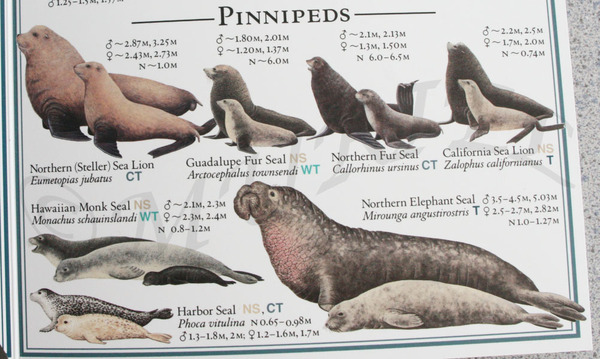What we called Sea Elephant is a seal, belonging to the same Pinnipeds relatives with Sea Lion and other kinds of seals.
海象應該叫象鼻海豹,屬海豹科,跟海獅與其他種海豹歸於鳍脚目 (海豹跟海狗、海獅最大分別在於海豹沒有外露的耳朵) 。

* These are “Pinnipeds” relatives. Elephant seals are sexually dimorphic, that is, the guys are much larger than the ladies. It is the largest pinniped species, which also means it is the largest species of seal.
象鼻海豹的男生體型遠遠大於女生。牠是世界上最大的鳍脚目物種,換言之,可說是最大的海豹。
There are two species: the Northern Elephant Seal (mirounga angustirostris) and the Southern Elephant Seal (mirounga leonina). The Northern ones, somewhat smaller than its Southern relative, ranges over the northeast Pacific ocean, along the coast of the US, Canada and Mexico, whereas Southern ones are found in the oceans around Antarctica. Both are earless seals.
象鼻海豹其實有兩種 - 北半球和南半球。北方小吻象海豹分佈在東北太平洋沿岸的美國,加拿大和墨西哥;南方象鼻海豹分佈在南極洲周圍的海洋。南方象鼻海豹又比北方小吻象海豹大些,兩者均為無耳海豹 (earless) 。
Both were nearly hunted to extinction by the end of the 19th century. One website said that the lowest count was between 1884 and 1892: 8 ~ 20 seals. How sad!
人類為了海豹皮和其油脂,大量捕殺南北象鼻海豹 (北海象的油脂品質僅次於抹香鯨),在十九世紀末瀕臨滅亡,在1884 與 1892 年間好像剩不到 20 隻,真慘!
A group of between 20-100 elephant seals that bred on
在瓜達盧佩島 (墨西哥的Baja California) 附近約 20-100 北海象倖存下來。墨西哥先立法保護,後來美國加入保育,他們數量已漸增加。在加州聖西蒙附近便有很多海象,一年到頭都可以看到。
Hester and I were going to visit

* On the way to the Elephant Seals Viewing Point, Hester took photos of the beautiful
沿途風景 - Hester 在車上拍得。

* Of course, this one was taken while we stopped at a nearby vista point.
這一張是在一個路邊觀景點拍得,加州的海邊真美!
N. Elephant Seal 北海象:
Elephant Seal - male to be exact - gets its name for its distinct proboscis, with the body of a seal.
牠們體型極大又有個大鼻子,故名。面上長有靈敏的觸鬚,能在水中偵測細微的水流。

Females: 2.5 ~ 3 meters long.
Males: 3.5 ~ 4.5 m long and HEAVY.
Pups: 125 cm (50 inches) long. 小海象約125公分長,35公斤重
Females give birth for the 1st time around 4 years old, with a life expectancy of 20 years. Males arrive at puberty around 4 years of age when its nose starts to grow. They have shorter lives - 14 years.
雌性生頭胎時大約4歲,壽命約 20 年。雄性大約4歲進入青春期,鼻子同時開始增長,比較短命,約 14 年。

* This one had a nose but not very distinct – I guessed it’s a juvenile.
這隻有突出的鼻子卻又不是特別明顯,我猜是隻少年仔。

* The guy’s BIG NOSE is used in making extraordinarily loud noises, especially during the mating season. Let me tell you, it’s LOUD.
我說男生特別吵,大鼻子發出隆隆的噪音;交配季節時,更吵。

* They all look dark gray to yellowish - brown. Pups are born with black lanugo and become silvery after molting.
膚色多銀灰或黃褐,小海象有黑色胎毛,脫皮後呈銀白。
They eat squid, octopus, fish, other bottom-dwelling fish, and sometimes even small sharks. They are sometimes preyed upon by killer whales.
海象吃魷魚,章魚,魚,底棲魚類,有時甚至是小鯊魚。有時候會成為殺人鯨的美食。
(I like squid and fish, too. Haha.)
Elephant seal is a deep-sea diver, a long distance traveler. They come together on land for a few months each year to give birth, mate, and molt. The rest of the year, individuals spend most of their time searching for food – just like me.
海象是超級深海潛水員,長途旅行者,牠們一起靠岸,交配,生小 babies,蛻皮,但是在海上的時間,牠們是獨行俠,大多時間都在找吃的 (怎麼跟我一樣?)。牠們視力佳,利深水捕獵。
While elephant seals are searching for food, they dive deep, DEEP into the ocean. Typically between 1000-2000 ft, the record shows 5,015ft by a male in 1991. The average of dive is 20-minute long, but they can dive for up to 2 hours. When they resurface, they only need 2-4 minutes before diving again.
海象在海中尋找食物,牠們可潛得極深。通常潛水至 1000 至 2000 英尺之間,但記錄是 1991 年的一隻公海象 - 超過 5015 英尺深。牠們平均一次潛水是 20 分鐘,但也可以潛至兩小時。 浮出水面後,只花 2-4 分鐘,就可再次潛水。

In November, male elephant seals start to haul-out. In December, females arrive and give birth to pups. Peak of births is usually last January (result of mating from previous season for the gestation is about 11 months).
通常在每年的 11 月,雄海象開始登上岸,雌海象 12 月上岸,開始生小寶寶 (是去年交配後的結晶) , 1 月是嬰兒出生高峰期。
They nurse for about a month on the richest milk in the mammal world. Mating occurs during the last 3-5 days of nursing. The mating season reaches its climax around Valentine’s Day and the adults return to the ocean.
哺乳期約一個月;哺乳期的最後幾天開始交配,交配季節大概在情人節達高峰,之後成年海象會回到海中。
So they have Valentine’s Day, too!!!
原來海象也過情人節呀!
Females and juvenile elephant seals return to molt in April and sub-adults return to molt in June, followed by adult elephants in July.
直到 4 月,雌海象與少年再回到岸邊開始蛻皮。
6 月時,青年海象 (Sub-adult) 到岸邊也開始蛻皮。
7 月時,成年雄海象也回來湊一腳。
The seals are fasting while they are on land, and lose about 1/3 of their body weight during the breeding season.
海象在岸上期間是禁食,在繁殖季節大約會掉 1 / 3 的體重。
I can’t fast that long, no wonder I can’t lose weight.
叫我禁食是不可能的,難怪瘦不下來。

* It was June when we visited, so I guessed this was a sub-adult.
Poor thing, he probably thought he looked so “not-decent” that he was distant from the rest of them.
這隻青年海象大概覺得自己 “穿著” 太不體面,離大家遠遠的。
Elephant seals are shielded from extreme cold by their blubber. The skin on top of this blubber and its hair molts periodically.
海象有很多的油脂 (blubber) 不怕冷,包著 blubber 的皮膚毛髮必須定期重新生長。
When molting occurs, the seal is vulnerable to the cold. They must rest on land - in a safe place. During this period, guys actually stop fighting with one another.
蛻皮這段期間,海象易受寒,必須在岸上休息,稱為 “haul-out.” 這段期間,海象們會停止打鬥。

* Playing with sands? The moisturized sands can keep the moisture, whereas the dry sands help block sunlight.
玩沙: 濕沙的水分蒸發時可降溫,乾沙也可防曬。

* They like to fight 愛打架
Hester's video
They can’t really “walk.”
牠們柔弱的前肢是不能在岸上行走,前進時得像毛蟲般擺動身體。

So tired after such “a huge step” – lie flat!
爬 “一大步” 好累,直接躺平。

* They spend a good deal of the daylight hours sleeping.
也愛日光浴 - 懶洋洋,真舒服。
我們去的那幾天,氣溫破記錄,熱得要命,看到牠們曬太陽,我覺得好熱呀!
We had to catch the tour at
如果不是要趕赫氏古堡已訂好的票,我大概會在那兒晃久一點,跟牠們一起悠閒悠閒!
More data from the internet - for your reference:
Now protected from hunting and harassment by the Marine Mammal Protection Act of 1972, the total population estimate in 1999 is around 150,000.
受到1972年海洋哺乳動物保護法的保護,北海象總數在 1999 年估計是15萬。不知現在又多多少了?
You cannot “touch” them for it is considered harassment. After all, they are wild animals and should not be approached - they are unpredictable and can cause great injury to humans, especially during breeding season.
不可以靠近去觸摸北海象,不管你多麼友善,都算做騷擾。
海象畢竟是野生動物,無法預知其行為,人去觸摸可能會受傷害,尤其是在牠們的繁殖季節。
The National Marine Fisheries Service, the Federal agency responsible for enforcing the Marine Mammal Protection Act, recommends a safe viewing distance of 50 to 100 feet. If seals are looking at you, you may be too close!
負責執行海洋哺乳動物保護法的國家海洋漁業服務處建議,安全的觀象距離約 50 至 100 英尺。如果海象正視著你,你可能就太接近啦!
Kingdom: Animalia 動物界
Phylum: Chordata 脊索動物門
Class: Mammalia 哺乳綱
Order: Carnivora 食肉目
- Suborder: Pinnipedia 鳍脚亞目
Family: Phocidae 海豹科
Genus: Mirounga 象海豹屬
Species: angustirostris 北方小吻象海豹

* 聽說還有一種海豹叫羅斯海豹 Ommatophoca rossi,不知跟 Ross 有沒有關係呀?






 留言列表
留言列表
